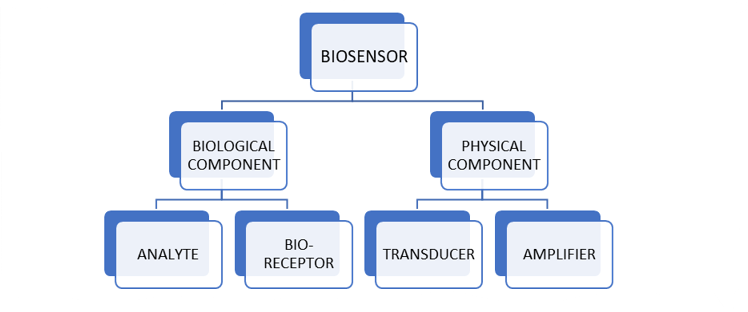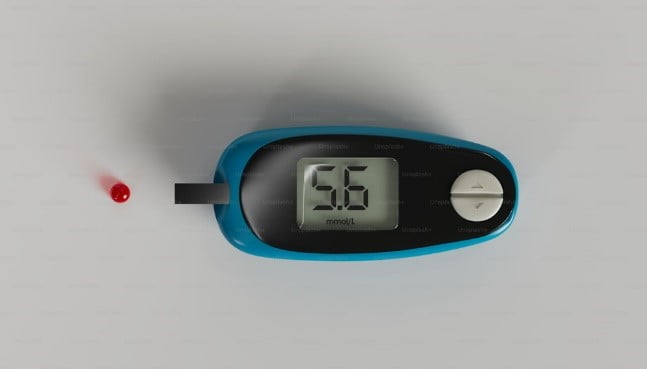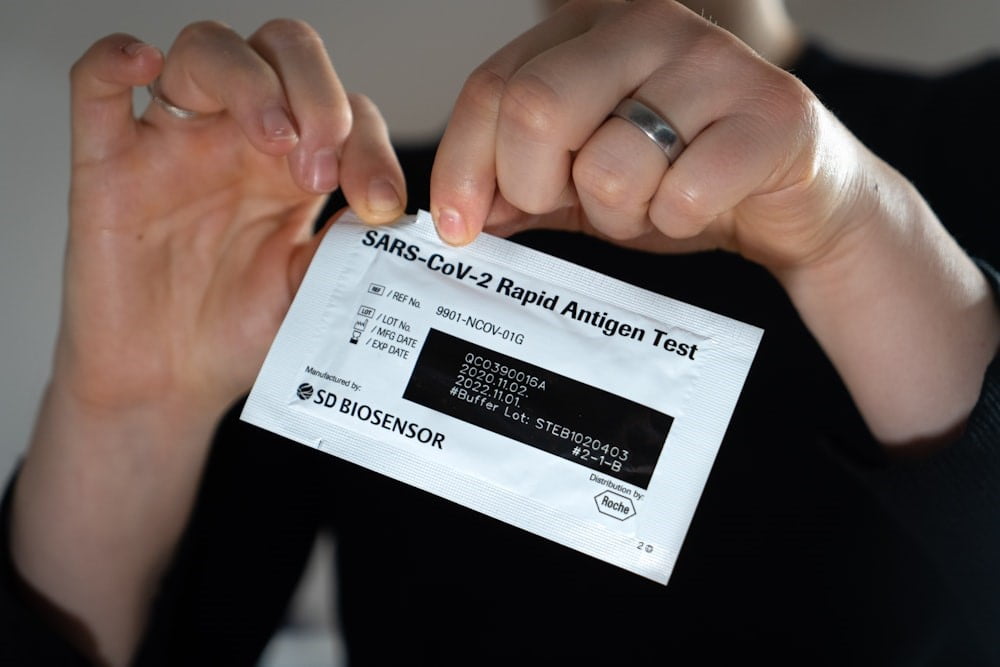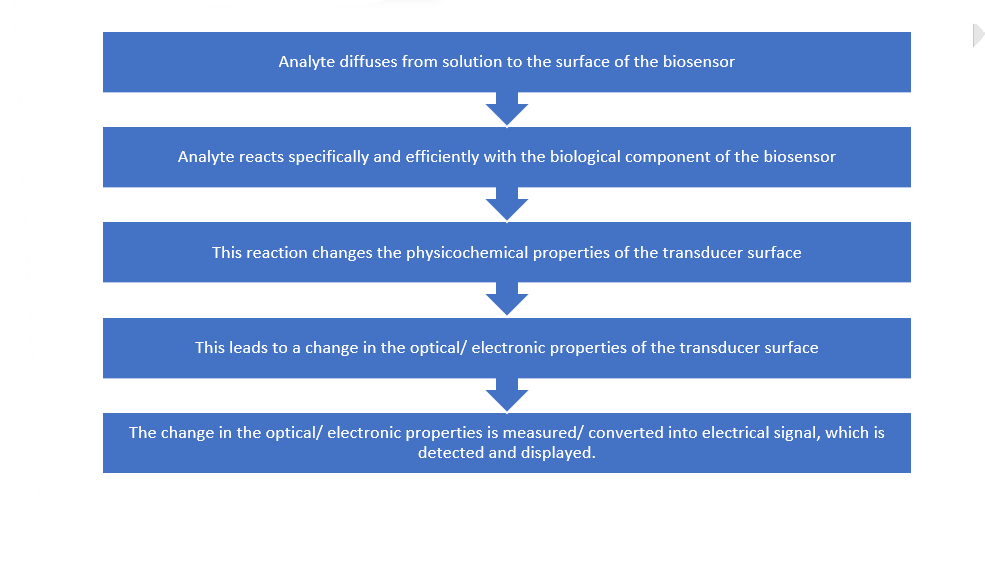
Author: Sanchali Gadade
ABSTRACT
Biosensors, also known as biological sensors, combine biological elements with physiochemical transducers to generate electronic signals in response to specific analytes. Since their creation in 1962 by Clark and Lyons, biosensors have evolved significantly, benefiting from advancements in electrochemistry, nanotechnology, and bioelectronics. These devices have revolutionized numerous fields, including biomedical diagnostics, environmental monitoring, and food safety. The key components of biosensors include bioreceptors, signal transducers, amplifiers, and displays, each playing a crucial role in detecting and quantifying analytes with high sensitivity and specificity. Various types of biosensors, such as electrochemical, physical, enzyme-based, tissue-based, immunosensors, and DNA biosensors, provide tailored solutions for diverse applications. The essential characteristics of biosensors, such as selectivity, reproducibility, stability, sensitivity, linearity, and resolution, define their performance and applicability. This paper delves into the intricate working principles, types, characteristics, and extensive applications of biosensors, highlighting their critical role in improving monitoring and detection capabilities and ultimately enhancing the quality of life.
INTRODUCTION
The short form of the biological sensor is known as a biosensor. Biosensor is a sensor that integrates a biological element with a physiochemical transducer to produce an electronic signal proportional to a single analyte which is then conveyed to a detector.
In this sensor, a biological element is maybe an enzyme, a nucleic acid otherwise an antibody. The bio-element communicates through the analyte being checked & the biological reply can be changed into an electrical signal using the transducer.[1]
The first biosensor invented by Clark and Lyons (1962) to measure glucose in biological samples utilized the strategy of electrochemical detection of oxygen or hydrogen peroxide using immobilized glucose oxidase electrode. Since then, incredible progress has been made both in technology and applications of biosensors with innovative approaches involving electrochemistry, nanotechnology to bioelectronics.[2]
The ability to detect even the slightest physiological change in the human body with high sensitivity and accurately monitor processes that impact human nature and their surroundings has led to an immense improvement in the quality of life. Biosensors continue to play a critical role across a myriad of fields including biomedical diagnosis, monitoring of treatment and disease progression, drug discovery, food control and environmental monitoring.[3]
COMPONENTS OF A BIOSENSORS
A typical biosensor is a composition of the two basic functional units, i.e., a “biorecognition element or bioreceptor” (enzyme, antibody, DNA, nucleic acid, peptide, etc.) and a physicochemical transducer such as optical, electrochemical, piezoelectric, and thermal.[4]

Analyte: A substance or molecule of interest to be detected is called analyte. Any protein, toxin, peptide, vitamin, sugar, and metal ion that needs to be detected forms the part of an analyte. For example, glucose is an ‘analyte’ in a biosensor designed to detect glucose.
Bioreceptor: A molecule that specifically recognises the analyte is known as a bioreceptor. Enzymes, cells, aptamers, deoxyribonucleic acid (DNA) and antibodies are some examples of bioreceptors. The process of signal generation (in the form of light, heat, pH, charge, or mass change, etc.) upon interaction of the bioreceptor with the analyte is termed bio-recognition.[5]
Signal Transducer: The specific recognition of the analyte molecule with bioreceptor generates a signal. The role of the transducer is to convert the bio-recognition event into a measurable signal. This process of energy conversion is known as signalisation. Common signalling principles are optical, electrical, electromechanical, thermal, magnetic, and pressure. Most transducers produce either optical or electrical signals that are usually proportional to the amount of analyte–bioreceptor interactions.
Amplifier: This is the part of a biosensor that processes the transduced signal and prepares it for display. It consists of complex electronic circuitry that performs signal conditioning such as amplification and conversion of signals from analogue into the digital form. The processed signals are then quantified by the display unit of the biosensor.5
Display: The display consists of a user interpretation system such as the liquid crystal display of a computer or a direct printer that generates numbers or curves understandable by the user. This part often consists of a combination of hardware and software that generates results of the biosensor in a user-friendly manner. The output signal on the display can be numeric, graphic, tabular or an image, depending on the requirements of the end user.5
WORKING PRINCIPLE
TYPES OF BIOSENSORS
Various types of biosensors being used are electrochemical, physical (piezoelectric and thermometric), enzyme-based, tissue-based, immunosensors, and DNA biosensors.
- ELECTROCHEMICAL BIOSENSORS
The electrochemical biosensor is the analytical devices that transduce biochemical events such as enzyme-substrate reaction and antigen-antibody interaction to electrical signals (e.g., current, voltage, impedance, etc)[6]. The 1st version of electrochemical biosensor was for estimation of blood glucose levels, developed by Clark.
These biosensors typically operate through enzymatic catalysis reactions that either consume or produce electrons. The enzymes are referred to as redox enzymes. This type of biosensor generally consists of three electrodes: a counter electrode, a reference electrode, and a working electrode. The analyte of interest participates in the reaction occurring at the surface of the active electrode, potentially causing electron transfer across the double-layer potential. The current generated can then be measured at a fixed potential.
Depending on the various types of signals transduced, electrochemical biosensors are further classified as follows:
- AMPEROMETRIC BIOSENSORS
- POTENTIOMETRIC BIOSENSORS
- IMPEDIMETRIC BIOSENSORS
- VOLTAMETRIC BIOSENSORS
- PHYSICAL BIOSENSORS
Psychical biosensors are the most fundamental as well as most widely use sensors. Physical biosensors find uses in inspecting the human mind, such as hearing, sight, and touch. A device that can detect reactions to physical stimuli can be categorized as a physical biosensor.[7]
- PIEZOELECTRIC BIOSENSORS
Piezoelectricity or piezoelectric effect is a physical phenomenon which refers to an ability of a material to produce voltage when mechanically stressed. The effect works in the oppose situation as well.[8] Piezoelectric Biosensors work by measuring the change in frequency which occurs when the antigen binds to the antibody receptor. The change in frequency is related to the change in mass by an equation. Piezoelectric immunosensors can detect antigens in the picogram range and can detect antigens in the gas phase as well as the liquid phase.
- THERMOMETRIC BIOSENSORS
Thermometric biosensors exploit the fundamental property of biological reactions, i.e. absorption or evolution of heat. This is reflected as a change in the temperature within the reaction medium. These biosensors predominantly measure the changes in temperature of the circulating fluid following the reaction of a suitable substrate with the immobilized enzyme molecules.
- ENZYME BASED BIOSENSORS
This sensor is one kind of analytical device, used to merge an enzyme using a transducer to generate a signal that is proportional to the concentration of the target analyte. Further, this signal can be amplified, stored, processed for later analysis.[9] These biosensors are useful tools for monitoring rapid changes in metabolic levels in real-time and includes pure enzyme preparations and biological processes.
- TISSUE BASED BIOSENSORS
These biosensors based on tissue structures in living animals can be used to detect and measure hormones, drugs, and toxins. Tissue based biosensors can be formed from genetically modified cells or by direct genetic modification to introduce biosensor proteins into a tissue in the animal. Biosensor cells transduce the concentration of the molecule being detected into a physical signal, which can be precisely measured.[10]
- IMMUNOSENSORS
Immunosensors are based on the principle that antibodies have high affinity to their antigens like antibodies and particularly combine to toxins or pathogens or interact through host immune system’s components.
These types of biosensors are based on affinity ligand solid-state devices where the reaction of immunochemical can be connected to a transducer.[11]
- DNA BIOSENSORS
DNA biosensors use nucleic acids as their biological receptors, detect proteins and non-macromolecular compounds that interact with certain DNA fragments known as DNA probes or DNA primers. The strong pairing of lined up nucleotide strands between bases in their complementary parts influence biosensors based on DNA, RNA, and peptide nucleotide acids to be the most sensitive tool.[12]
BASIC CHARACTERISTICS
Biosensors possess certain static and dynamic attributes, optimisation of which is reflective of the performance of the biosensor.
- SELECTIVITY: The ability of a bioreceptor to detect a specific analyte in a sample containing other admixtures and contaminants.
- REPRODUCIBILITY: The ability of the biosensor to generate identical responses for a duplicated experimental set-up.
- STABILITY: The degree of susceptibility to ambient disturbances in and around the biosensing system.
- SENSITIVITY: The minimum amount of analyte that can be detected by a biosensor defines its limit of detection (LOD) or sensitivity.
- LINEARITY: Linearity is the attribute that shows the accuracy of the measured response (for a set of measurements with different concentrations of analyte) to a straight line, mathematically represented as y=mc, where c is the concentration of the analyte, y is the output signal, and m is the sensitivity of the biosensor.
- RESOLUTION: The smallest change in the concentration of an analyte that is required to bring a change in the response of the biosensor.[13]
APPLICATIONS
- Food Industry
In food processing, biosensors address the challenges of quality and safety by offering real-time, cost-effective, and selective monitoring alternatives to traditional methods like chemical experiments and spectroscopy. They have been used for:
- Ageing of Beer: Enzymatic biosensors based on cobalt phthalocyanine effectively monitor beer aging during storage.
- Pathogen Detection: Biosensors detect E. coli in vegetables, indicating faecal contamination by measuring pH variations caused by ammonia produced by urease-E. coli antibody conjugates.
- Dairy Industry: A screen-printed carbon electrode biosensor quantifies organophosphate pesticides in milk.
- Sweetener Detection: Electrochemical biosensors combined with lipid films distinguish between natural sugars (glucose, sucrose) and artificial sweeteners (saccharin, cyclamate).
- Fermentation Processes
Biosensors optimize and control fermentation processes by monitoring products, biomass, enzymes, antibodies, or by-products. They are widely used in China to detect glucose, lactate, lysine, and ethanol. For example, glucose biosensors have replaced the traditional Fehling’s method in saccharification monitoring.
- Sustainable Food Safety
Biosensors ensure food quality and safety by detecting general and specific toxicities, such as:
Pesticides: Immunosensors detect organophosphates and carbamic insecticides in foods like wine and orange juice.
Toxic Metals: Bacteria-based bioassays measure arsenic levels.
- Medical Field
- Biosensors have broad medical applications, including:
- Diabetes Management: Glucose biosensors are essential for home-based blood-glucose monitoring.

- Infectious Disease Diagnosis: Developing biosensors for UTIs and pathogen identification.

- Heart Failure: HfO2-based biosensors detect human interleukin-10 for early-stage heart failure diagnosis.
- Cancer Detection: Biosensors detect multiple cancer markers and assist in clinical immunophenotyping of acute leukaemia.[14]
Biosensors offer a versatile and powerful tool across various fields, improving efficiency, accuracy, and real-time monitoring capabilities beyond traditional methods.
CONCLUSION
Biosensors have revolutionized analytical detection and monitoring across multiple sectors. From their initial use in glucose monitoring to their current applications in medical diagnostics, environmental monitoring, and food safety, biosensors offer unparalleled sensitivity and specificity. The integration of biological recognition elements with advanced transduction mechanisms has enabled the detection of minute physiological changes and the precise monitoring of various analytes.
The diverse types of biosensors, including electrochemical, physical, enzyme-based, tissue-based, immunosensors, and DNA biosensors, cater to specific needs and applications, showcasing their versatility and robustness. As technology continues to advance, the development and refinement of biosensors will undoubtedly lead to even more innovative solutions, further enhancing their impact on healthcare, environmental stewardship, and industrial processes. Biosensors stand as a testament to the power of interdisciplinary innovation, bridging biology, chemistry, and electronics to address some of the most pressing challenges in modern science and technology.
REFERENCES
- Acha, Victor, Thomas Andrews, Qin Huang, Dhiraj K. Sardar, and Peter J. Hornsby. “Tissue-Based Biosensors.” In Recognition Receptors in Biosensors, edited by Mohammed Zourob, 365–81. New York, NY: Springer, 2010. https://doi.org/10.1007/978-1-4419-0919-0_9.
- Agarwal, Tarun. “Biosensor – Principle, Components, Types & Their Applications.” ElProCus – Electronic Projects for Engineering Students, November 12, 2018. https://www.elprocus.com/what-is-a-biosensor-types-of-biosensors-and-applications/.
- Bhalla, Nikhil, Pawan Jolly, Nello Formisano, and Pedro Estrela. “Introduction to Biosensors.” Essays in Biochemistry 60, no. 1 (June 30, 2016): 1–8. https://doi.org/10.1042/EBC20150001.
- Cho, Il-Hoon, Dong Hyung Kim, and Sangsoo Park. “Electrochemical Biosensors: Perspective on Functional Nanomaterials for on-Site Analysis.” Biomaterials Research 24, no. 1 (February 4, 2020): 6. https://doi.org/10.1186/s40824-019-0181-y.
- Citrogene. “Types of Biosensors,” June 7, 2021. https://www.citrogene.com/types-of-biosensors/.
- Mehrotra, Parikha. “Biosensors and Their Applications – A Review.” Journal of Oral Biology and Craniofacial Research 6, no. 2 (2016): 153–59. https://doi.org/10.1016/j.jobcr.2015.12.002.
- Pohanka, Miroslav. “Overview of Piezoelectric Biosensors, Immunosensors and DNA Sensors and Their Applications.” Materials 11, no. 3 (March 19, 2018): 448. https://doi.org/10.3390/ma11030448.
- Tetyana, Phumlani, Poslet Shumbula, and Zikhona Njengele-Tetyana. “Biosensors: Design, Development and Applications,” 2021. https://doi.org/10.5772/intechopen.97576.
- Vigneshvar, S., C. C. Sudhakumari, Balasubramanian Senthilkumaran, and Hridayesh Prakash. “Recent Advances in Biosensor Technology for Potential Applications – An Overview.” Frontiers in Bioengineering and Biotechnology 4 (February 16, 2016). https://doi.org/10.3389/fbioe.2016.00011.

